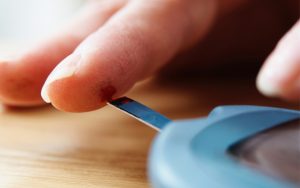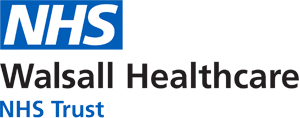5. Monitoring your blood glucose
Monitoring your blood glucose control shows the effect of your treatment and indicates when any changes in treatment are needed.
There are two main ways to monitor your blood glucose control – random blood glucose tests and HbA1c:
Random blood glucose testing
Random blood glucose is normally measured by doing a finger-prick blood sample and shows the blood glucose level at the time the test is taken.
 It is normal for the blood glucose level to change throughout the day and for levels to rise after eating. The best times to test are just before a meal or 2 hours after a meal. The usual target range for this test is 4-7 mmol/l before meals and below 9mmol/l when tested 2 hours after meals.
It is normal for the blood glucose level to change throughout the day and for levels to rise after eating. The best times to test are just before a meal or 2 hours after a meal. The usual target range for this test is 4-7 mmol/l before meals and below 9mmol/l when tested 2 hours after meals.
Your healthcare professional will agree with you what your target range should be, show you how to test and advise you when to test.
As a random blood glucose test only tells you what the blood glucose level is at the time you take it, a series of tests gives the most useful information about your blood glucose control.
If you find that your results are regularly outside your target range please contact your healthcare professional to review your treatment.
Random blood glucose testing is important if you are on insulin or tablets that stimulate the pancreas to make more insulin as you could be at risk of hypoglycaemia (low blood glucose).
If you have not been asked to test your blood glucose by your healthcare professional, you may not be able to get prescriptions for the test strips. Test strips are not usually prescribed if you are on diet only or taking medication that does not stimulate the pancreas to make more insulin as it is unlikely that your blood glucose would go too low.
HbA1c
This blood test measures the amount of glucose that has stuck to the red blood cells whilst they have been circulating in the blood. This test reflects the blood glucose control over the past three months. The usual target range for this test is 48 – 53 mmol/mol. Your health care professional will tell you what your target range should be.
Low blood glucose levels (hypoglycaemia or “hypo”)
Hypoglycaemia is when your blood glucose level below is too low (below 4 mmol/l). This can occur when on insulin injections or medications that make the pancreas produce more insulin. This is why it is important to know how your medication works. If unsure, ask your healthcare professional or Pharmacist how your medication works and if it could cause hypoglycaemia.
Signs and symptoms of hypoglycaemia include:
- Excessive sweating
- Trembling/ shaking
- Feeling anxious
- Tingling of the lips
- Hunger
- Going pale
- Palpitations (heart pounding)
- Blurred vision
- Difficulty concentrating
- Change from normal behaviour e.g. unusually aggressive or tearful
Low blood glucose levels can be caused by:
- Delayed or missed meal/snack
- Eating less starchy food than usual
- Being more activity than usual
- Taking too much insulin or diabetes tablets
- Drinking too much alcohol or drinking alcohol without having starchy food
It is important to never stop your diabetes medication if you have had a hypo. If you are having hypos more than twice a week you MUST arrange to see your healthcare professional to review your treatment.
High blood glucose levels (hyperglycaemia or “hyper”)
Hyperglycaemia is when your blood glucose level is too high. Symptoms of this include:
- Tiredness and loss of energy
- Increased thirst
- Passing more urine than usual
- Recurring infections e.g. thrush, urine infections, skin infections
High blood glucose levels can be caused by:
- Eating/drinking more sugar and/or starch than usual
- Not having the right medication (insulin or tablets)
- Taking less exercise than usual
- Emotional stress
- An infection or illness
- Certain medications e.g. steroid tablets/steroid injections
You should discuss your high blood glucose levels with your healthcare professional.
If you have Type 1 Diabetes remember to test for ketones if you have high random blood glucose, feel unwell or have signs/symptoms of ketones (see sick day rules below).
If you need advice about your insulin dose please contact your healthcare professional.
Sick day rules
When you are ill, have an infection or are stressed your blood glucose levels may increase. If you test your blood glucose levels you should aim to test at least four times a day when ill.
It is important not to stop taking your diabetes medication when you are ill, unless you were previously advised that you should do so. You need to get advice from your healthcare professional if you are unsure about how to manage your diabetes during illness. You MUST contact your healthcare professional if you vomit more than once, or have signs/symptoms of ketones.
If you take insulin you may need to give additional insulin. If you are unsure how much to take please contact your healthcare professional.
Please note if you have Type 1 diabetes you should never omit your insulin.
It is recommended that you have the flu vaccination. This will reduce your risk of flu which can affect your blood glucose control and increase the chance of other health complications.
